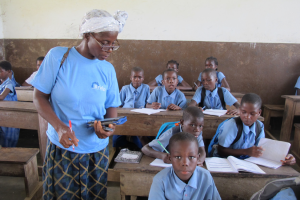The path to sustainability for the Liberian Education Advancement Programme
“The Ministry of Education previously stated its intermediate-term goal to double the government’s education investment by 2020”
In 2016, Liberia – one of the poorest countries in the world – embarked upon the world’s most innovative public-private partnerships in education. Its government was determined to improve learning outcomes for children.
Now three years in, it’s time to revisit whether the dramatic learning gains for students in the Partnership Schools for Liberia’s (PSL) first year have been sustained. If so, it would be a strong indication that the Liberian Ministry of Education is on the right track with its reform program “Getting to Best.”
Researchers showed initial learning gains equivalent to 60% more learning for PSL overall, and more than an additional year of learning for students in schools operated by the most successful providers (Romero et al., 2018).

PSL, now rebranded as the Liberian Education Advancement Program (LEAP), has been heavily subsidized by philanthropists and donors. The Government of Liberia’s current investment in schooling, approximately $50 USD per student annually, is clearly insufficient to achieve the bold vision contained in “Getting to Best.”
The Ministry of Education has previously stated its intermediate-term goal to double the government’s education investment by 2020. Even so, the average per-pupil expenditure for operators’ (excluding Bridge) is slightly more than double this anticipated increase to Liberia’s education budget.
Bridge International Academies, the LEAP partner with the highest overall investment, spent an estimated $373 per student in the program’s first year. It was clear then and remains so now that the LEAP operators must close this gap between current expenditures and projected funds available to ensure its sustainability.
Bridge International Academies reports that it is on target to achieve significant economies of scale and its schools will operate sustainably at scale. Indeed, this is happening. As Bridge has more than doubled its student enrollment from 9,000 to 20,000, its total expenditure has dropped from $5.76M to $4.30M. Bridge reduced its per-pupil expenditures in year two (2017-18) to $215, slightly more than half of what it spent per pupil (not including one-time start-up costs) in year one ($373).
“The government of Liberia’s current investment in schooling… is clearly insufficient to achieve the bold vision contained in ‘Getting to Best'”
Its year three costs are estimated to drop further still. Bridge projects its costs to drop to $60 per student if and when the number of Bridge schools reaches 500. This $60 target is consistent with Bridge’s instructional program-related expenditures for schools in Kenya and Nigeria. Bridge expects advances in technology and economies of scale across the entire organization to close the remaining $10 per pupil gap between its costs and what the government has agreed to pay.
The anticipated long-term productivity benefits to better education suggest that if LEAP expands to all students, the investment will pay off handsomely. The Ministry is well-aware of existing research, such as Eric Hanushek’s estimates of 2% return to average annual growth rate in Gross Domestic Product for a one standard deviation increase in student test scores[1].
The long-term returns to educational improvement are significant; Hanushek estimates that even a reform plan that takes 20 years to improve by 0.5sd will increase GDP by 5% in 32 years. Should the LEAP program show similar improvement over time and as it expands, the economic returns to Liberia could be tremendous.
Early indications regarding student performance are positive. While we await the findings of the three-year randomized controlled trial, Bridge’s internal research has shown its students’ performance remains high, even as the program expands to serve students in the more remote southeast parts of Liberia.
“Early indications regarding student performance are positive”
Furthermore, the benefits appear cumulative. As students remain at Bridge supported schools, their performance in literacy accelerates. Bridge third grade students who enrolled in the program’s first year and have remained there since are performing as well as its fifth-grade students did just two years ago.
53% of these third-grade students are proficient readers and 28% are basic readers, compared to none in either of these categories just two and a half years ago. The contrast to typical Liberian school students is stark: According to a 2012 USAid study, only 7% of Liberian third graders achieved the 50 words per minute benchmark for oral reading fluency.

Sustainability remains an important consideration for the LEAP program, but as operator efficiencies lower costs and the evidence accumulates for student performance gains, it provides hope and optimism that better education is within reach for all Liberian students.
About the author: Steve Cantrell is vice president of Measurement and Evaluation at Bridge International Academies and a senior fellow at George Washington University’s FutureEd. He is a former head of evaluation and research at the Bill & Melinda Gates Foundation.
Leave a Reply